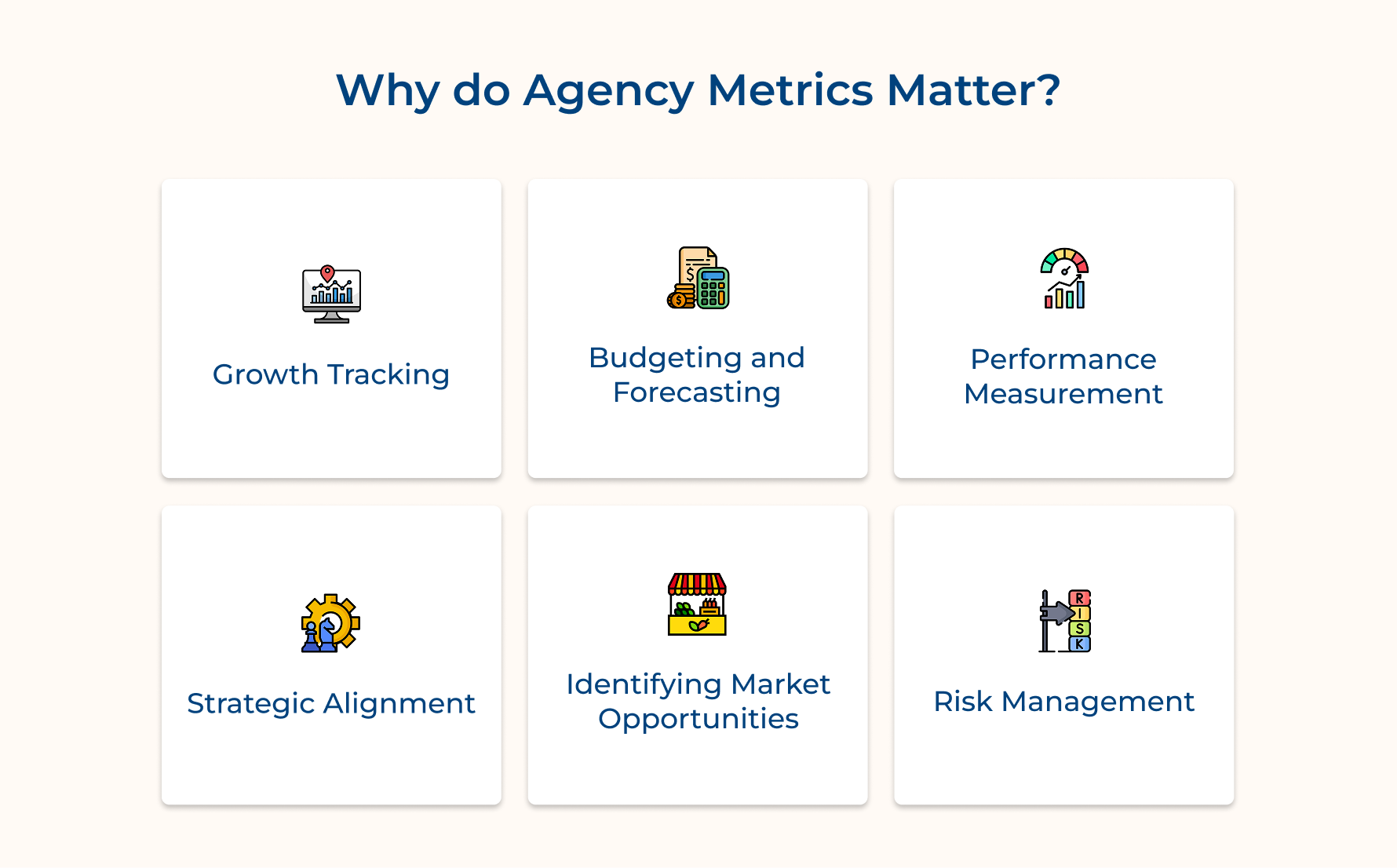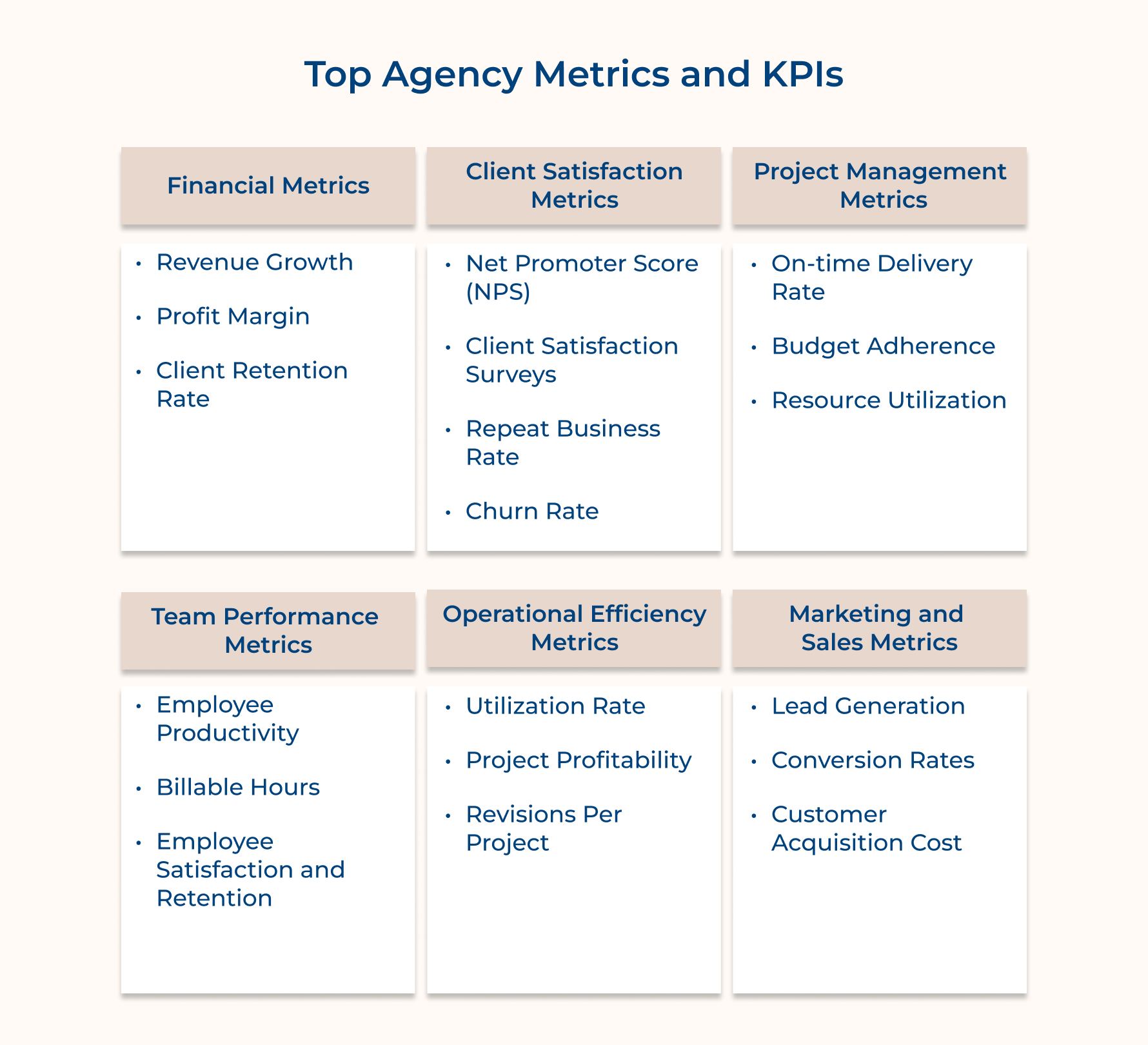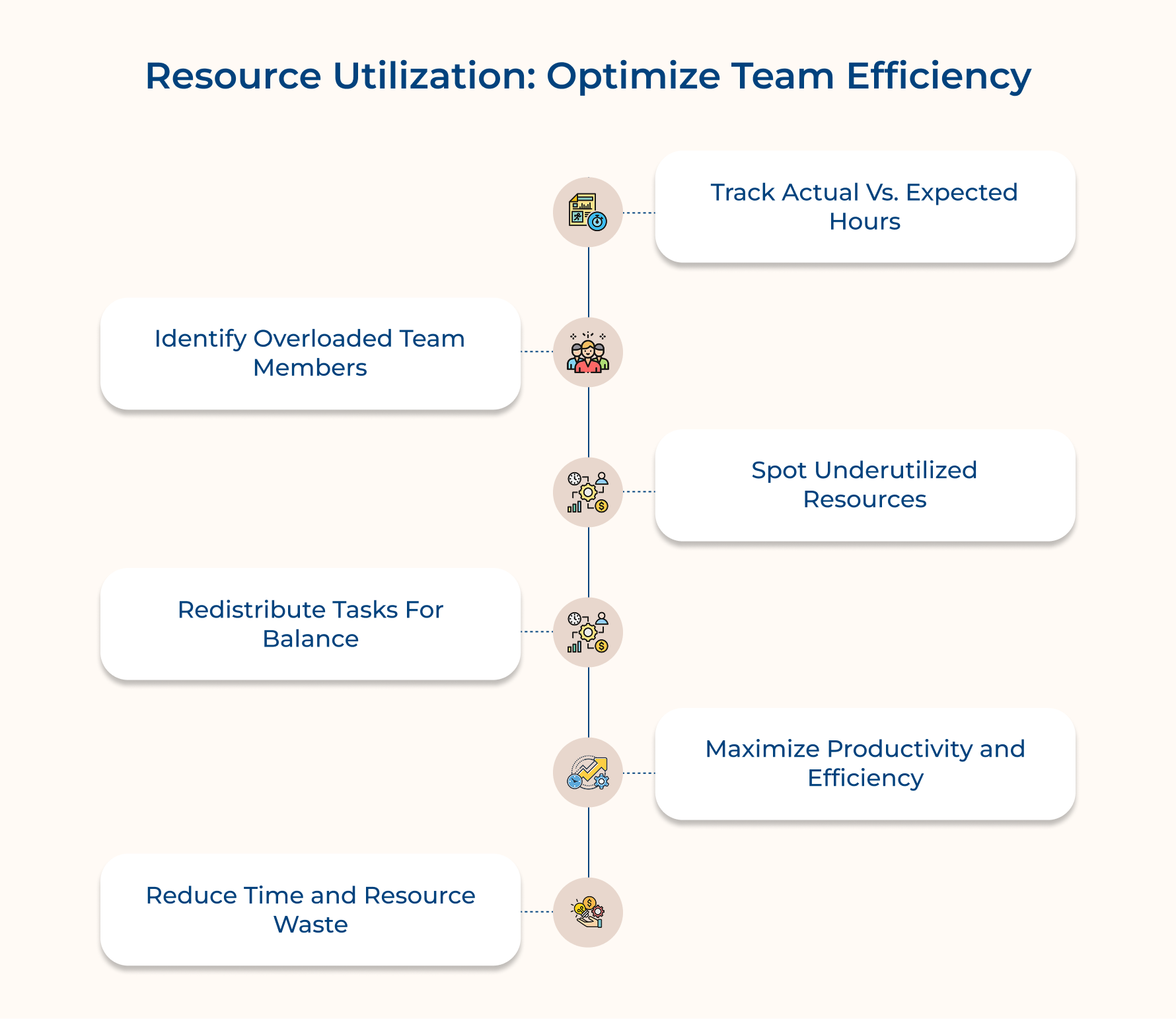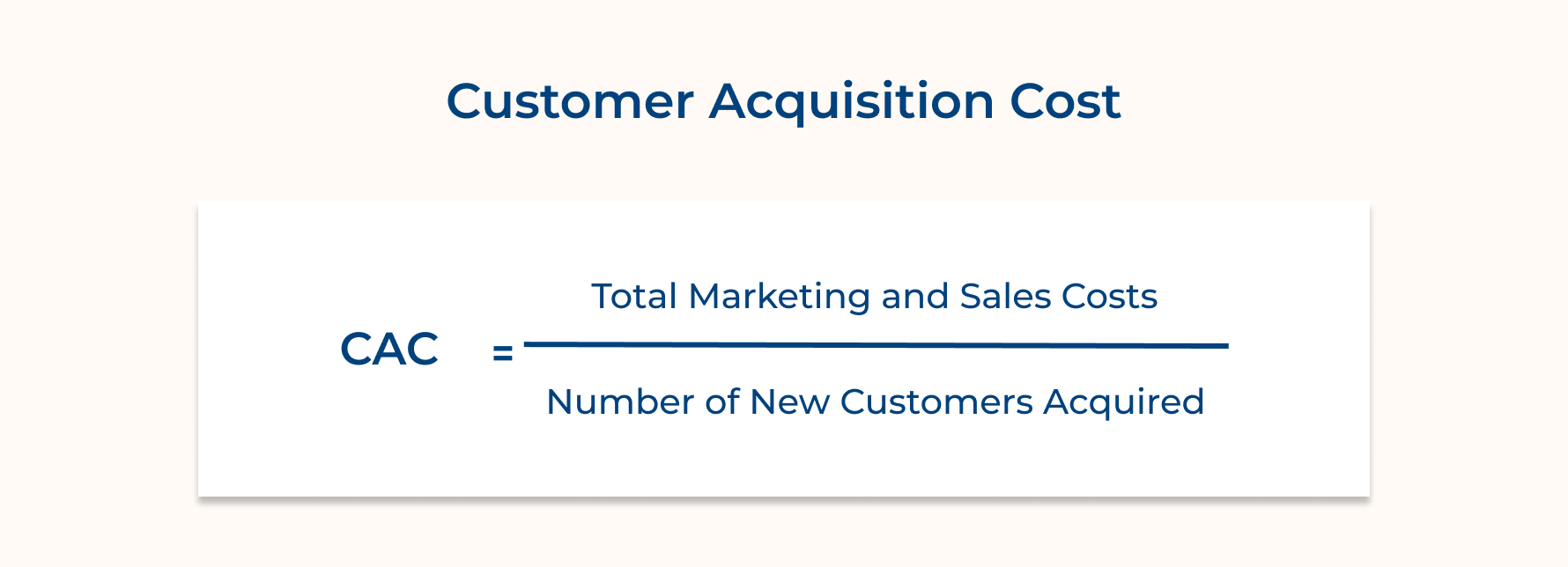Top 17 Agency Metrics & KPIs to Boost Performance

Key Highlights
Many agencies find it tough to pinpoint the right metrics that truly drive success. Gaining clear insights is key—it helps streamline operations, boost client satisfaction, and, in turn, fuel growth as well as profitability.
Imagine having access to key performance indicators (KPIs) that illuminate strengths and weaknesses while guiding strategic decisions.
We’ll explore essential agency metrics, highlighting their importance and offering actionable tips for effective analysis. Dive in to discover how to leverage metrics to unlock your agency’s full potential and achieve sustainable growth!
Why do Agency Metrics Matter?
Agency metrics are quantitative measurements used to evaluate performance, efficiency, and overall effectiveness within an agency. Let’s understand why they matter.
Growth tracking: Tracking agency metrics helps you understand overall growth. Analyzing revenue and client acquisition enables you to set realistic goals as well as recognize trends that support sustainable expansion.
Budgeting and forecasting: Smart budgeting comes down to using the right metrics. Evaluating past performance helps agencies anticipate future trends and allocate resources wisely to ensure financial stability.
Performance measurement: Get a clear framework for assessing performance across various areas. The approach highlights both strengths and weaknesses allowing for continuous improvement in projects as well as team productivity.
Strategic alignment: Metrics keep everyone on the same page, aligning the team with the agency’s goals. Tracking progress through key performance indicators (KPIs) builds collaboration and keeps everyone focused on achieving shared objectives.
Identifying market opportunities: Regularly analyzing metrics reveals shifts in market demand and emerging trends. Such insights allow agencies to adapt their services as well as marketing strategies to capture new opportunities.
Risk management: Monitoring financial and operational metrics is essential for early risk identification. A proactive approach enables agencies to address issues promptly safeguarding operations and maintaining client trust.
Top Agency Metrics and KPIs for Enhanced Profitability
Identifying and monitoring the right metrics as well as KPIs can significantly boost profitability. Here are the top metrics to focus on.
Financial Metrics & KPIs
Financial metrics provide insights into an agency’s economic health and sustainability. Here are the key financial metrics to track regularly.
1. Revenue Growth
Keeping an eye on revenue growth is crucial for gauging the health of your business and spotting trends. It gives you valuable insights into market demand and helps you set realistic financial goals for the future.
By analyzing revenue growth over time, agencies can assess their performance and make informed decisions about scaling operations or tweaking strategies.
Set quarterly revenue targets based on past performance and industry benchmarks. Regularly review financial reports to identify growth areas and adjust strategies accordingly.
2. Profit Margin
Profit margin shows the percentage of revenue that turns into profit after all expenses are deducted.
Understanding your profit margin is crucial for any agency looking to turn revenue into real profit. It’s a key indicator of how efficiently you’re running your business and can help you pinpoint where you might cut costs or adjust pricing.
Keeping an eye on this metric allows you to assess how profitable your different services and client projects are, which can help you make smarter decisions about where to allocate your resources and how to set your prices.
3. Client Retention Rate
Making your clients happy and coming back for more is key to sustainable growth. High client retention rates signal that your clients are satisfied and loyal, which is not only great for your reputation but also more cost-effective than bringing in new clients.
By tracking your retention rates, you can spot trends and hone in on areas that need improvement in your client relationships as well as service delivery.
Client Satisfaction Metrics
Measuring client satisfaction is essential for building lasting relationships and driving loyalty. Here are the most impactful metrics to consider.
4. Net Promoter Score (NPS)
Net Promoter Score (NPS) is a fantastic way to gauge how loyal and satisfied your clients are with your agency.
The metric gives you a peek into how they view your services and can be a great indicator of your reputation as well as the likelihood of getting referrals.
The higher your NPS, the stronger your standing in the eyes of your clients!
By diving into the NPS data, you can pinpoint what you’re doing well and where you might need to step up your game in terms of service delivery and client engagement.
5. Client Satisfaction Surveys
Regular client satisfaction surveys give you direct insights into their experiences and expectations, which is super helpful for spotting areas that could use a little improvement.
Diving into the survey results helps you make smart adjustments to your offerings and ensure you’re meeting your client’s needs effectively.
However, how to make it effective?
- Design concise surveys that zero in on the key aspects of the client experience. This way, clients are more likely to complete them and give you valuable feedback.
- Don’t just collect the data—follow up with specific action plans based on what you learn.
- Address any issues highlighted in the surveys to show clients you’re listening and committed to enhancing their experience.
6. Repeat Business Rate
A high repeat business rate is a clear sign that you’ve built strong relationships with your clients and that they’re happy with your services.
It doesn’t just boost client satisfaction but also leads to stable revenue and growth for your agency.
This formula gives you a percentage that helps you understand how many of your clients come back for more.
7. Churn Rate
The churn rate measures the percentage of clients lost over a specific period. High churn rates can signal issues with service quality or client satisfaction.
Tracking churn allows agencies to pinpoint areas of concern and implement strategies to improve client retention. Conduct exit interviews with clients who leave to identify reasons for churn.
Project Management Metrics
Effective project management metrics help optimize workflows and improve delivery. Here are the vital metrics to enhance project outcomes.
8. On-Time Delivery Rate
Timely delivery is essential for keeping your clients happy and building their trust. By keeping an eye on this metric, you can ensure that projects are finished when you say they will be.
Plus, monitoring delivery rates helps you assess how well your team is performing and spot any bottlenecks in your project management processes.
How to leverage this metric?
- Set clear deadlines for each phase of a project and check in on progress regularly.
- Use project management tools to keep track of tasks and deadlines more effectively.
9. Budget Adherence
Let’s say you’re managing a marketing campaign. If you notice that the costs for digital ads consistently exceed what you planned, you can dive in and figure out why—maybe the cost per click is higher than expected or you’re not getting the engagement you hoped for.
With that insight, you can tweak your budget or strategy for the next campaign to avoid the same pitfalls.
Keeping an eye on budget adherence is key to making sure your projects stay financially viable and don’t go overboard on spending.
Break down project budgets into detailed line items so you can track everything more effectively. Review budget performance at regular intervals throughout the project to catch any issues early.
10. Resource Utilization
Imagine you have a design team working on multiple projects.
If you track how many hours each designer spends on their tasks versus the time expected for those projects, you might discover that one designer is consistently overloaded while another has extra bandwidth.
The insight allows you to redistribute tasks, ensuring everyone is working efficiently and no one is overwhelmed.
Making the most of your resources is essential for maximizing productivity and cutting down on waste, which directly impacts your bottom line.
So, keep tabs on employee hours compared to project requirements to spot any over- or under-utilization.
Team Performance Metrics
Team performance metrics evaluate productivity and collaboration within your agency. Here are the key metrics to monitor for effective performance.
11. Employee Productivity
Measuring employee productivity helps identify high performers and areas where additional training or resources may be needed.
Use productivity metrics to set benchmarks for performance and motivate team members through recognition as well as rewards.
Tips to enhance productivity:
- Establish clear performance metrics and communicate them to the team.
- Regularly review productivity data to identify trends and provide feedback.
12. Billable Hours
Tracking billable hours is essential for understanding revenue generation and ensuring that resources are being utilized effectively.
Here’s how you can improve:
- Use time-tracking software to accurately record billable hours on projects.
- Set goals for billable hours to encourage productivity among team members.
- Analyze billable hours to determine project profitability and inform future pricing strategies.
13. Employee Satisfaction and Retention
High employee satisfaction leads to better performance and lower turnover rates, positively impacting overall agency performance.
Tips to consider:
- Conduct anonymous surveys to gather honest feedback from employees.
- Implement changes based on feedback to improve work conditions and morale.
- Regularly assess employee satisfaction to identify areas for improvement and develop strategies to enhance workplace culture.
Operational Efficiency Metrics
Operational efficiency metrics assess how well resources are utilized. Here are the critical metrics that can enhance operational performance.
14. Utilization Rate
Utilization rate measures how effectively employees’ time is spent on billable work versus non-billable tasks.
High utilization rates indicate efficient use of resources. Use utilization metrics to assess team performance and identify areas for improvement in time management.
Let’s say a designer works 40 hours in a week. Out of those, 30 hours are spent on billable projects. Using the formula, the utilization rate would be:
Hence, by going through the formula, it means that the designer is utilizing 75% of their available hours for billable work, which is a strong indication of productivity.
15. Project Profitability
Let’s say your agency has just wrapped up two projects:
Project A brought in $50,000 in revenue, but cost $35,000 to complete, leaving you with a $15,000 profit.
Project B, on the other hand, generated $45,000 but only cost $25,000, resulting in a $20,000 profit.
Analyzing these outcomes shows that Project B was more profitable and may signal a type of work or client that’s worth pursuing in the future.
Project profitability is essential to make sure each project is adding to the agency’s bottom line, helping you make smart choices about future work.
By looking at which projects and services bring in the best returns, you can focus on the areas that make the biggest impact.
16. Revisions Per Project
Tracking revisions helps gauge client satisfaction and project clarity, revealing potential issues in communication or project scope.
Analyze revision data to identify patterns and improve initial project proposals as well as client communications.
How to improve productivity?
- Set clear guidelines for the number of revisions included in project scopes.
- Gather client feedback early in the project to minimize revisions later.
Marketing and Sales Metrics
Tracking marketing and sales metrics helps gauge campaign effectiveness along with revenue generation. Here are the essential metrics to analyze for growth.
17. Lead Generation
Tracking lead generation is essential for assessing the effectiveness of marketing efforts and identifying potential revenue sources.
Use lead generation data to refine marketing strategies and allocate resources to the most effective channels.
Here are different platforms through which you can collect lead generation data,
- Website forms
- Social media
- Content offers
- Chatbots & Email signups
- Referral programs
Here’s how you can maximize your lead generation strategy,
- Monitor lead sources to identify which channels yield the best results.
- Implement targeted campaigns based on lead generation insights.
18. Conversion Rates
High conversion rates show that your marketing and sales efforts are really connecting with your audience as well as driving revenue. Observing this metric helps you fine-tune your approach.
For example, if 100 people visit your website and 10 make a purchase, your conversion rate would be (10 ÷ 100) x 100 = 10%.
19. Customer Acquisition Cost
Knowing your customer acquisition cost (CAC) is key to understanding how effectively your marketing and sales are working.
If your CAC is too high, it can eat into your profits, making it hard to scale. By tracking CAC, you can see if your campaigns are paying off and adjust your budget for the best results.
For example: If you spend $5,000 on marketing in a month and acquire 50 new customers, your CAC would be $5,000 ÷ 50, which equals $100. It means you’re spending $100 to bring in each new customer.
Challenges in Tracking Agency Metrics
Tracking as well as analyzing metrics can present several challenges. Here are the common obstacles agencies face and how to overcome them.
Data Overload
Agencies often collect vast amounts of data, making it difficult to identify relevant metrics.
Solve it by: Focusing on a few key performance indicators (KPIs) that align with your business goals and objectives. Regularly review and prioritize the data you collect, ensuring it remains manageable. Implement a data hierarchy to distinguish between critical as well as supplementary information.
Lack of Standardization
Inconsistent data collection methods can lead to unreliable metrics.
Fix it through: Establishing standardized processes for data collection and reporting, including templates as well as guidelines for teams to follow. Invest in tools that ensure uniformity across all departments, enabling a cohesive approach to metrics tracking and reporting.
Difficulty in Interpretation
Complex data can be hard to understand, leading to misinterpretation of results.
Tips to fix: Provide comprehensive training for team members on data analysis techniques and best practices. Utilize data visualization tools and dashboards that present information in a clear, digestible format. Thus, making it easier for stakeholders to grasp key insights.
Resistance to Change
Teams may be hesitant to adopt new metrics or processes.
Solve it by: Communicating the benefits of tracking metrics clearly, emphasizing how they contribute to the agency’s success and individual roles. Involve team members in the development and implementation of new processes, encouraging a sense of ownership as well as accountability.
Time Constraints
Tracking and analyzing metrics can be time-consuming, diverting focus from core activities.
Fix it through: Automating data collection and reporting where possible to reduce manual workload. Use integrated tools that align with existing workflows to streamline processes, allowing teams to focus more on strategic tasks rather than data entry.
Ways to Collect and Analyze Metrics
Analyzing metrics is crucial for informed decision-making as well as optimizing agency performance. Here’s a step-by-step guide on how to effectively gather and interpret metrics.
1. Define Clear Objectives
Start by getting clear on what you want to measure and why. Set specific goals that align with your agency’s overall strategy. It helps you focus on the metrics that truly matter, making data collection more targeted and meaningful.
2. Choose Relevant Metrics
Pick the key performance indicators (KPIs) that align with your goals. Keep it manageable — choose a few metrics that offer real insights. For example, if improving client satisfaction is your focus, you might track metrics like Net Promoter Score (NPS) and client retention rates.
3. Implement Data Collection Tools
Use tools and software to streamline data collection. CRM systems, project management tools, and analytics software can save you time as well as reduce errors by automating the process. Regularly updated data is more reliable and makes analysis easier.
4. Establish a Standardized Process
Create a simple, standardized process for collecting data. Develop templates and guidelines so your team follows a consistent approach. It makes analyzing data across teams and projects smoother as well as more insightful.
5. Regularly Review and Update Data
Schedule regular check-ins, either monthly or quarterly, to review and update your data. The ongoing review helps you monitor progress, spot trends, and adjust as needed. Be open to refining your metrics and goals based on any shifts in priorities.
6. Analyze the Data
Use analytical tools to dig into your data. Visualization tools like dashboards can help make sense of complex data by presenting it in a clear, visual format. Look for patterns, trends, and unexpected results that could provide insights into your performance.
7. Take Action Based on Insights
Let the insights from your analysis guide your next steps. Adjust processes, reallocate resources, or set new goals based on what the data reveals. And remember to periodically revisit your metrics to ensure they still align with your agency’s evolving goals.
Transforming Data into Business Growth
Focusing on agency metrics enables organizations to drive informed decision-making and build growth. Key performance indicators (KPIs) provide valuable insights into operations and client satisfaction while helping teams identify strengths as well as areas for improvement.
Embracing a data-driven approach enhances efficiency and ensures alignment with business objectives. A proactive mindset allows for continuous adaptation to market changes and emerging challenges. Metrics serve as a roadmap to direct teams toward optimal performance.
Ultimately, leveraging the right metrics empowers agencies to unlock their full potential. Such capabilities facilitate sustainable success and position agencies to thrive in a competitive environment.
Limit time — not creativity
Everything you need for customer support, marketing & sales.
Neeti Singh is a passionate content writer at Kooper, where he transforms complex concepts into clear, engaging and actionable content. With a keen eye for detail and a love for technology, Tushar Joshi crafts blog posts, guides and articles that help readers navigate the fast-evolving world of software solutions.











